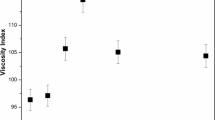Abstract
The primary biodegradability of two types of paraffinic base oils (solvent and catalytically dewaxed oils) and their blends was evaluated using the CEC L-33-A-93 test. The biodegradability values varied between 10% and 75%. Base oil mixtures displayed varying contents in aromatic and polar compounds and a wide range of kinematic viscosity (KV) values, from roughly 10 to 600 cSt (at 40°C), while their viscosity indices were almost constant (90-100). The biodegradability of oils was closely related to their content in polycyclic aromatic hydrocarbons and was also decreasing with kinematic viscosity. For the two types of base oils, a linear relationship could be set between the biodegradation percentages and the logarithms of KV values. These results show that, beside overall chemical features such as the contents in aromatic compounds, KV may be a prominent parameter for assessing the primary biodegradability of mineral base oils.
Similar content being viewed by others
References
Amund OO & Adebiyi AG (1991) Effect of viscosity on the biodegradability of automotive lubricating oils. Tribol. Int. 24: 235–237
ASTM Committee D2 on petroleum products and lubricants, standard D 445, current edition, American Society for Testing Materials, Philadelphia, Dec 10, 1997
ASTM Committee D2 on petroleum products and lubricants, standard D 2270, current edition, American Society for Testing Materials, Philadelphia, March 15, 1993
Basu B, Singh MP, Kapur GS, Ali N, Sastry MIS, Jain SK, Srivastana SP & Bhatnagar AK (1998) Prediction of biodegradability of mineral base oils from chemical composition using artificial neural networks. Tribol. Int. 31: 159–168
Battersby NS & Hery C (1998) Development and applications of environmentally acceptable hydraulic fluids. SAE Technical Paper Series 981493, Earthmoving Industry Conference and Exposition, April 1998, Peoria, Illinois
Battersby NS & Morgan P (1997) A note on the use of the CEC L-33–A-93 test to predict the potential biodegradation of mineral oil based lubricants in soil. Chemosphere 35: 1773–1779
Battersby NS, Pack SE & Watkinson RJ (1992) A correlation between the biodegradability of oils products in the CEC L-33–T-82 and modified Sturm tests. Chemosphere 24: 1989–2000
Carpenter JF (1994) Biodegradability of polyalphaolefin (PAO) basestocks. Lubr. Eng. 50: 359–362
CEC, Co-ordinating European Council for the development of performance tests for transportation fuels, lubricants and other fluids (1995) Biodegradability of Two-Stroke Cycle Outboard Engine Oils in Water, approved test method CEC L-33–A-93
Cerniglia CE (1993) Biodegradation of polycyclic aromatic hydrocarbons. Curr. Opin. Biotechnol. 4: 331–338
Cornish A, Battersby NS & Watkinson RJ (1993) Environmental fate of mineral, vegetable and transesterified vegetable oils. Pestic. Sci. 37: 173–178
Gibson DT & Subramanian V (1984) Microbial degradation of aromatic hydrocarbons. In: Gibson DT (Ed) Microbial Degradation of Organic Compounds (pp 181–252). Marcel Dekker, New York
Kioupis LI & Maginn EJ (1999) Rheology, dynamics, and structure of hydrocarbon blends: a molecular dynamics study of n-hexane/n-hexadecane mixtures. Chem. Eng. J. 74: 129–146
Leahy JG & Colwell RR (1990) Microbial degradation of hydrocarbons in the environment. Microbiol. Rev. 54: 305–315
Moore JD, Cui ST, Cummings PT & Cochran HD (1997) Lubricant characterization by molecular simulation. AIChE J. 43: 3260–3263.
Novick NJ, Mehta PG & McGoldrick PB (1996) Assessment of the biodegradability of mineral oil and synthetic ester base stocks, using CO2 ultimate biodegradability tests and CEC-L-33–T-82. J. Synth. Lubr. 13: 19–30
Riis V, Miethe D & Möder M (1996) Analytical characterization of the persistent residues after microbial degradation of mineral oils. Fresen. J. Anal. Chem. 356: 378–384
Sugiura K, Ishihara M, Shimauchi T & Harayama S (1997) Physicochemical properties and biodegradability of crude oil. Environ. Sci. Technol. 31: 45–51
Van Donkelaar P (1990) Environmental effects of crankcase and mixed lubrication. Sci. Total Environ. 92: 165–179
Völtz M, Yates NC & Gegner E (1995) Biodegradability of lubricant base stocks and fully formulated products. J. Synth. Lubr. 12: 215–230
Walker JD, Colwell RR & Petrakis L (1975) Microbial petroleum degradation: application of computerized mass spectrometry. Can. J. Microbiol. 21: 1760–1767
Willing A (1999) Oleochemical esters - environmentally compatible raw materials for oils and lubricants from renewable resources. Fett/Lipid 6: 192–198
Author information
Authors and Affiliations
Rights and permissions
About this article
Cite this article
Haus, F., Junter, GA. & German, J. Viscosity properties of mineral paraffinic base oils as a key factor in their primary biodegradability. Biodegradation 11, 365–369 (2000). https://doi.org/10.1023/A:1011672016757
Issue Date:
DOI: https://doi.org/10.1023/A:1011672016757




